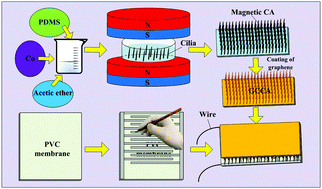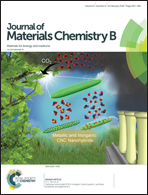Bio-inspired highly flexible dual-mode electronic cilia†
Abstract
Inspired by biological cilia, a highly flexible dual-mode electronic cilia (EC) sensor is fabricated from graphene-coated magnetic cilia arrays. Polydimethylsiloxane is used as a matrix to make the artificial cilia flexible while Co particles are used to endow the cilia with magnetic properties and graphene coating is employed to make the cilia conductive. The EC-based sensor shows a high sensitivity of 0.4% Pa−1 for a pressure of 0–100 Pa and a low detection limit of 0.9 Pa. The responsive behavior of the EC-based sensor is highly stable in a wide frequency range of 0.1–10 Hz up to 10 000 cycles. Meanwhile, the magnetic field sensitivity of the EC sensor is around 12.08 T−1 for a magnetic field intensity of 150–160 mT. Consequently, the EC sensor is successfully applied in blood pulse monitoring, pressure and magnetic field switching, and visualized pressure and magnetic field detection. Due to its high sensitivity, high durability and dual-mode responsiveness, the flexible EC sensor goes far beyond the capability of human skin, and is believed to have great potential in healthcare, robotics, e-skin and smart surgical tools, etc.



 Please wait while we load your content...
Please wait while we load your content...